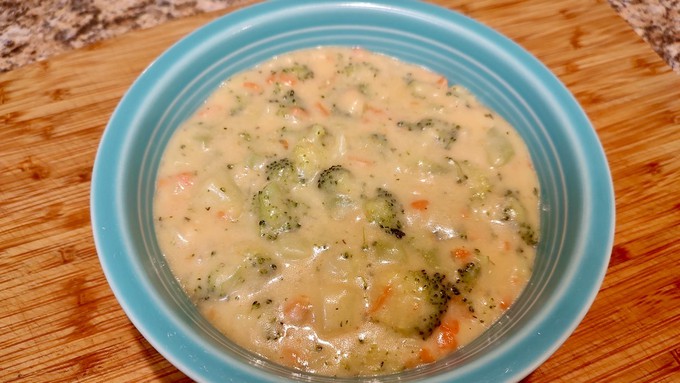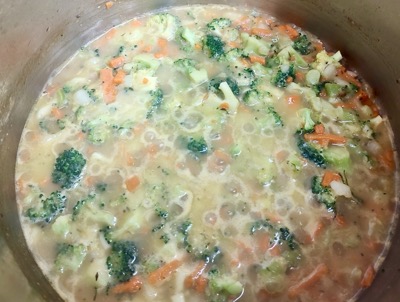
Recipe: Hearty winter warmer also is gluten-free

This hearty bowl of broccoli-cheese soup is creamy thanks to potato, not cream or flour. Debbie Arrington
Cream soups (particularly cheese soups) can seem like thinned sauce or gravy. That’s because they basically are just that. The ingredients used for thickening are the same: Cream, butter and flour.
Skip the roux and grab a potato. This recipe for broccoli-cheddar cheese soup uses one medium potato to give silkiness to the soup base and thicken it without adding flour. Another switch: 1% milk for cream.
Instead of putting all the broccoli in the pot at once, save out the tender florets and add them later. With less cooking, they hold their form.
The sharper the cheddar, the cheesier the soup (I used half medium, half sharp). The addition of Parmesan cheese accentuates the cheddar. Be careful not to boil the soup after the addition of cheese; it will separate and get grainy. Instead, gently reheat, if necessary.
Creamy broccoli-cheddar cheese soup
Makes 4 servings
Ingredients:
¼ cup butter or margarine (½ stick)
½ cup onion, chopped
3 cups vegetable broth
1 carrot, peeled and julienned (about ¾ cup)
1 medium potato, peeled and cubed (about 1 cup)
¼ teaspoon thyme
1 large broccoli crown (10 ounces; makes about 4 cups, chopped)
Salt and pepper to taste
1 cup milk, preferably 1%
2 cups grated cheddar cheese
¼ cup grated Parmesan cheese
Instructions:
In a large heavy pot or saucepan over medium heat, melt butter. Sauté onions until very soft, about 10 minutes.

Add broth and bring to a boil. Add carrot, potato and thyme. Bring to boil, then reduce heat. Simmer for 10 minutes.
Chop broccoli crown, separating the stems from the florets. Add stems to broth, adjusting heat as necessary. Simmer for 10 more minutes, then add florets.
Continue simmering broth and vegetables until the broccoli stems are tender and the potato is dissolving into the broth (about 10 more minutes).
Adjust seasoning, adding salt and pepper if necessary.
Stir in milk. Bring back to simmer but don’t boil.
Remove soup from stove and stir in cheeses. Stir until the cheeses are melted and blended into the soup.
Return to heat briefly, if necessary, so soup is evenly warmed through, being careful not to boil.
Serve immediately.
Comments
0 comments have been posted.Sacramento Digs Gardening to your inbox.
Sites We Like
Garden Checklist for week of July 21
Your garden needs you!
* Keep your vegetable garden watered, mulched and weeded. Water before 8 a.m. to reduce the chance of fungal infection and to conserve moisture.
* Feed vegetable plants bone meal, rock phosphate or other fertilizers high in phosphate to stimulate more blooms and fruiting. (But wait until daily high temperatures drop out of the 100s.)
* Don’t let tomatoes wilt or dry out completely. Give tomatoes a deep watering two to three times a week.
* Harvest vegetables promptly to encourage plants to produce more. Squash especially tends to grow rapidly in hot weather. Keep an eye on zucchini.
* Pinch back chrysanthemums for bushy plants and more flowers in September.
* Remove spent flowers from roses, daylilies and other bloomers as they finish flowering.
* Pinch off blooms from basil so the plant will grow more leaves.
* Cut back lavender after flowering to promote a second bloom.
* It's not too late to add a splash of color. Plant petunias, snapdragons, zinnias and marigolds.
* From seed, plant corn, pumpkins, radishes, winter squash and sunflowers.